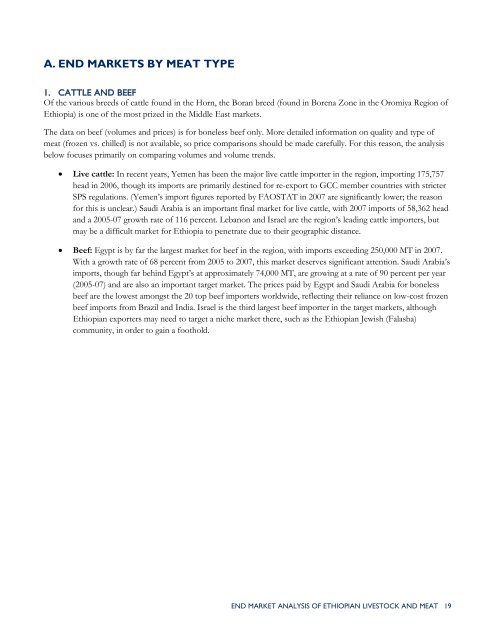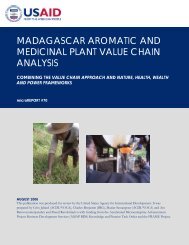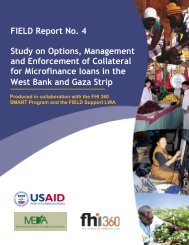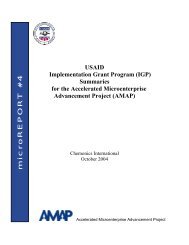End Market Analysis of Ethiopian Livestock and ... - USAID Microlinks
End Market Analysis of Ethiopian Livestock and ... - USAID Microlinks
End Market Analysis of Ethiopian Livestock and ... - USAID Microlinks
Create successful ePaper yourself
Turn your PDF publications into a flip-book with our unique Google optimized e-Paper software.
A. END MARKETS BY MEAT TYPE<br />
1. CATTLE AND BEEF<br />
Of the various breeds <strong>of</strong> cattle found in the Horn, the Boran breed (found in Borena Zone in the Oromiya Region <strong>of</strong><br />
Ethiopia) is one <strong>of</strong> the most prized in the Middle East markets.<br />
The data on beef (volumes <strong>and</strong> prices) is for boneless beef only. More detailed information on quality <strong>and</strong> type <strong>of</strong><br />
meat (frozen vs. chilled) is not available, so price comparisons should be made carefully. For this reason, the analysis<br />
below focuses primarily on comparing volumes <strong>and</strong> volume trends.<br />
• Live cattle: In recent years, Yemen has been the major live cattle importer in the region, importing 175,757<br />
head in 2006, though its imports are primarily destined for re-export to GCC member countries with stricter<br />
SPS regulations. (Yemen’s import figures reported by FAOSTAT in 2007 are significantly lower; the reason<br />
for this is unclear.) Saudi Arabia is an important final market for live cattle, with 2007 imports <strong>of</strong> 58,362 head<br />
<strong>and</strong> a 2005-07 growth rate <strong>of</strong> 116 percent. Lebanon <strong>and</strong> Israel are the region’s leading cattle importers, but<br />
may be a difficult market for Ethiopia to penetrate due to their geographic distance.<br />
• Beef: Egypt is by far the largest market for beef in the region, with imports exceeding 250,000 MT in 2007.<br />
With a growth rate <strong>of</strong> 68 percent from 2005 to 2007, this market deserves significant attention. Saudi Arabia’s<br />
imports, though far behind Egypt’s at approximately 74,000 MT, are growing at a rate <strong>of</strong> 90 percent per year<br />
(2005-07) <strong>and</strong> are also an important target market. The prices paid by Egypt <strong>and</strong> Saudi Arabia for boneless<br />
beef are the lowest amongst the 20 top beef importers worldwide, reflecting their reliance on low-cost frozen<br />
beef imports from Brazil <strong>and</strong> India. Israel is the third largest beef importer in the target markets, although<br />
<strong>Ethiopian</strong> exporters may need to target a niche market there, such as the <strong>Ethiopian</strong> Jewish (Falasha)<br />
community, in order to gain a foothold.<br />
END MARKET ANALYSIS OF ETHIOPIAN LIVESTOCK AND MEAT 19





